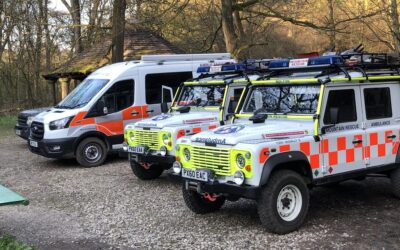Every year Lancashire Constabulary kindly offer to the Mountain Rescue Teams operating in Lancashire, places on their week long Police Initial Missing From Home Managers Course. (Missing Persons)
Last week, commencing on Tuesday 1st July, very experienced and long serving (Since 1967 ! ) Bolton MRT Team Call Out list member, who is also one of our Life Vice Presidents, Alan James, commenced his attendance on this Police nationally recognised course.
Held at the Lancashire Constabulary Training centre at Hutton, within the HQ and Training complex of Lancashire Constabulary, this course attracted students from serving Lancashire Constabulary Officers, mostly of Sergeant and Inspector rank, with everybody present having a large amount of practical experience of ’Missing from Home’ search enquiries and operations.
The whole course was excellently organised and facilitated by very experienced Officers from Lancashire Constabulary, including Officers from the Civil Contingencies Unit.
Rossendale and Pendle MRT were also in attendance, with Peter Goble their Team Leader (also an NWAS HART member) attending alongside Bowland Pennine MRT very experienced team member Julian Earnshaw.
There follows a personal account of the course, which ran from Tuesday 1st July until Friday 4th July 2014, from Alan James;
“On the first day we were introduced to the methods and decision making processes used by the Police when faced with a possible missing person report, including the way the police use their internal reporting systems, which systems to use and when, grading of responses and hierarchies of command. – how “FIMs”, “Misper Managers” and “Polsas” are expected to operate together.
The Police now use statistical tables compiled by the Grampian Police, which are similar in outline to the ones that MR teams had historically used “borrowed” from US sources and modified for UK use.
These are relied upon to justify and plan the initial stages of a search.
The course considered an example Scenario of a missing person report and attempted to establish the appropriate plan of action.
We were given a talk by a communications investigator on the methods available for using telephone data to find a missing person – including ringing them up!
Mobile phone companies can supply some data on the use of a phone including where it was last used, of varying accuracy and usefulness, dependant upon the circumstances and urgency.
We were made aware of some of the limitations and complexities of cellphone tracing, including that most mobile phone shops have their own “pico cells” – a tiny equivalent of a mobile phone mast, giving the shop a permanently strong connection, but being intensely localised.
MR have also developed a technique called SARLOC for finding where a “lost” person who has called for help is, by sending them a temporary application for their mobile phone.
It was also explained when it is appropriate to use some of these methods.
On the Wednesday, the course visited the Lancashire Fire and Rescue Service Urban Search and Rescue station at Euxton, Chorley.
The USAR unit is equipped with several very large vehicles with demountable equipment “pods” capable of dealing with major building collapses or vehicle and railway incidents.
USAR also have a search dog facility, these dogs are trained to find live casualties in difficult urban rescue situations such as building collapses.
The course was given a presentation by the UK Missing Person’s Bureau – set up in 2008 – who try to match missing persons with found ones.
Of interest to search managers, the bureau are currently carrying out an update to the Grampian search statistics which currently have a Scottish bias – “iFind” – “Interpreting Found Incident data”, to incorporate newer and more English and Welsh data. There is an invitation to suggest other data groupings not currently provided.
There is a public website: missingpersons.police.co.uk
The course members also carried out a practical search exercise in the grounds of the Lancashire Constabulary Mounted Division.
The search practice included the “In Field” search planning and record keeping using the Lancashire Police documentation.
The search included large fields of long grass – bunny rabbits running round everywhere! , a pond and some woodland areas.
Oh! – Apparently we don’t use sticks to search – we use our eyes! …. oops!
During the course, an introduction to Mountain Rescue was given by very long serving and experienced Simon Harris of Bowland Pennine MRT, including a demonstration of how SARMAN can be used to plan and organise searches.
This created a lot of interest from the Police and Fire Service attendees present.
Simon’s specialist subject is plainly tracking and “cutting of sign”, which is a useful skill to develop and elements can be used during “normal” searches.
The National Police Air Support Unit gave a presentation – what helicopters can do for us and their limitations – and how the Warton branch of NPAS (NPAS 23) has the prettiest helicopter!
Important points are that the command structure is in West Yorkshire, but the individual units have a large degree of freedom for self tasking.
They are still useful despite being directed from the WRONG side of the Pennines.
The group was given a presentation by Child Rescue Alert – a Police body who coordinate nationally the dissemination of public alerts of missing children, and open call centre facilities across the country to receive information from the public and pass it for analysis.
They have the difficult task of deciding when and how to put out national alerts.
The Alzheimer’s Society gave a presentation and video.
This presentation sought to explain the variable nature of dementia and how and why sufferers behave, to give potential searchers an understanding of where they might go and why.
Lancashire Constabulary have an initiative “Operation Forget-Me-Not” disseminated to the care community to encourage prompt notification to the police whenever a person goes missing.
The video was a very powerful one illustrating the way a dementia sufferer sees the world in contrast with the way the world sees them.
We were discouraged from describing a dementia sufferer as “wandering” about, because they are most likely travelling with a purpose, it is often the case that the world has altered around their perceptions.
The group had another search exercise in the grounds of a commercial livery stable premises, this search contained more difficult ground than the previous exercise and sought to reinforce clue finding.
This exercise was started in heavy drizzle, both maps and searchers got soggy.
Full marks to the woman Police Officer who found a small piece of woollen pullover on some barbed wire.
The course ended on Friday afternoon, 4th July 2014, with all attending having gained a comprehensive insight in to Missing Persons.
The culmination of the course for those available was a practical search exercise on Saturday 5th July 2014, held at Brockholes Nature Reserve, Preston, involving Lancashire Constabulary Officers, Bowland Pennine MRT, and Rossendale and Pendle MRT, with the students present on the course being presented with various exercise search scenarios to complete.
Due to operational reasons, the Bolton MRT was not able to take part in this exercise.”
In July 2010 our Team Leader Garry Rhodes MBE and Training Officer at the time (Known to our regular readers nowadays as a Mountain Rescue Trailing Search Dog Navigator) Elaine Gilliland attended this valued course, followed by our Team ‘IT’ guru and webmaster Paul Brain who attended this course in November 2011.
In January 2013, our now Deputy Team Leader Chris Greenhalgh and current Equipment Officer – IT and Communications, Steve Fletcher, attended this course.
Their respective detailed reports on this course can be found within the ‘news’ section of our website for the relevant dates.
The Bolton MRT is very grateful to Lancashire Constabulary for their fantastic support in allowing us to send Alan James to fully participate on this very valuable, practical experience based training course.



